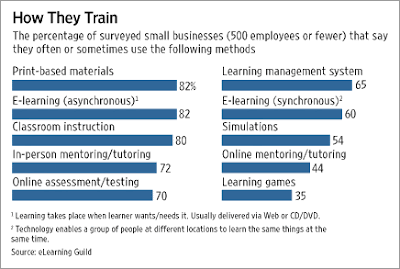
This month's ASTD Big Question on the
Learning Circuit's Blog is about Social Networking and finding help and expertise if you have a question or a concern for which you need input and/or advice. The basic question is "
If you need input from people, where's the best place to ask?"But, then the question breaks into sub-questions.
-How to reach out and find expertise
-How to use Social Media to Find Answers to Questions
-How to Learn through Conversation
And then the questions are even broken down further into more sub-questions which you can read for yourself at the original ASTD Blog posting
Network Feedback.
The assumption seems to be that there is one "best" place for asking a question. One social network for Learning Management System questions and, perhaps another, for a question about learning strategies or business strategies or marketing strategies. If only you could pinpoint that particular location or network then you could be more efficient in finding answers.
I think the question sort of misses the power of social networking and Web 2.0 tools. Let me explain.
In the old days (before Web 2.0) when working a network to find information the whole process was severely constrained by time and resources. Seeking out advice, counsel and ideas from your network or a related network was time consuming and costly. You had to take the time to make a phone call to a friend who, hopefully, knew someone who might be able to answer the question. Then you had to call that person, reference the discussion with your friend and launch into an explanation of the question you wanted to have answered. That person would, possibly, answer your question for free, offer to help for a fee, or refer you to another person.
If they referred you to another person, you had to start all over again with more phone calls, explanations, etc. It could literally take you all day to find the one person who had the specific answer you needed. You really had to "work your network" to find the right person to answer your question. You had to hope the Return-On-Investment for the time you spent finding the answer was worth it. There was really no cost effective way for the average person to "broadcast" a question to a large group of people.
With Web 2.0 and social networks, the cost of asking a question and seeking advice from several different channels simultaneously is so minimal that it no longer matters whether or not you know the right place to ask the question. Ask it in multiple places because you never know who might have the answer and the overall cost is negligible. And once you ask the question, you can then work in parallel until the answer arrives. You don't need to stop working while seeking the answer.
For example, we have an alumni network consisting of professionals who have graduated from Bloomsburg University with a Master's Degree in Instructional Technology (very competent and accomplished folks.) If I need to ask a question or seek input from the field I do the following:
-Send the question to our Yahoo! Group Listserv
-Post a discussion question in our NING network
-Post a question in our LinkedIn network
-Ask a question to the alumni group on Facebook
-Send a group email via our CAC Conference web site which has registered members
Total time to post the question in all five places...about 5 minutes. The ROI for using all five methods is phenomenal. I invest a small amount of time writing the question, copy and paste it into the proper location in the social media spaces and SHAZAM! I have hundreds of folks (maybe even thousands) who have the potential to answer the question. I don't need to pinpoint or target a specific group or person. In this case there is some overlap but if you broaden the concept beyond alumni...even the overlap is reduced.
I think this low cost of "working the network" is the power of Web 2.0 and social media and is what makes it so effective. Therefore, I don't think a whole lot of time needs to be dedicated to finding the "best place to ask a question." Instead, place it out there to multiple networks and wait for an answer.
__
Catalog of Recommended Books, Games and GadgetsRecommended Games and GadgetsRecommended BooksContent Guide

























